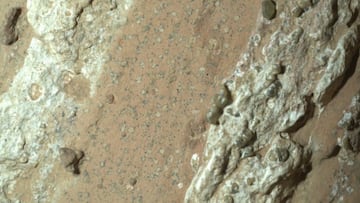What did NASA discover on Mars that could be a sign of past life on the planet?
NASA’s Perseverance Rover has discovered a rock on Mars that scientists say could point to the presence of life on the planet billions of years ago.

NASA scientists have recently announced the discovery of signs in a Martian rock that could indicate the presence of life on the neighboring planet billions of years ago. However, they admit will have to conduct more research to know for sure, including studying the rock in a lab.
These possible signs of fossilized microscopic life have been found in a rock, named Cheyava Falls, in the Jezero crater, where a wide variety of organic compounds have already been discovered in an ancient lake from which a river flowed.
READ ALSO: Secret revealed as NASA discovers planet in our solar system is stuffed with diamonds
NASA looking at other explanations
“The rock exhibits chemical signatures and structures that could possibly have been formed by life billions of years ago, when the area now explored by Perseverance contained running water,” NASA explained on social media.
In addition to describing the find as an “intriguing rock,” NASA clarified that the scientific team is considering other explanations for its observed characteristics, and that future research steps will be required to determine whether ancient life is a valid explanation.
Our @NASAPersevere Mars rover has found an interesting rock that could be one of the best signs yet that ancient microbial life may have once existed on the Red Planet. However, we'll need to do more research to know for sure: https://t.co/tWpQD6Rcg6 pic.twitter.com/wOfA62VYQo
— NASA (@NASA) July 25, 2024
READ ALSO: Ready for the iPhone 16 series?
Martian rock with leopard spots
The analysis, carried out by instruments on board the Perseverance rover, has shown that the “leopard spots” on the rock – around three feet long and 1.5 feet wide– have qualities that fit the definition of a possible indicator of ancient life.
Although all the work carried out has shown that this rock contains compounds that are considered to be the basic components of life, NASA has warned that these molecules can also be formed through non-biological processes.
Too early to tell
“We can’t say this is a sign of life,” said NASA Perseverance deputy project scientist Katie Stack Morgan, “but this is the most compelling sign we’ve found so far.”
Related stories
NASA has pointed out that this is not the first time signs of possible life have been detected on Mars.
In the last ten years, the Curiosity robot has found a source of methane and samples of rocks enriched with carbon isotopes, among other things.


Complete your personal details to comment